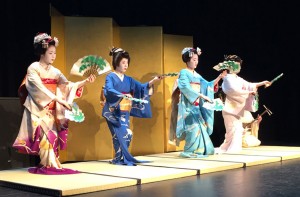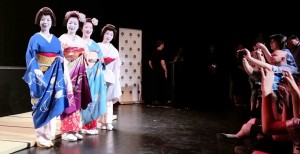JQ Magazine: ‘Jewels of Kyoto’ Brings Geisha Tradition to Australia

Jewels of Kyoto performed Matsu Zukushi in Sydney Feb. 23. This dance is characterized by the use of fans with a pine branch design, which represents the courage, determination and fidelity of a woman. (Eden Law)
By Eden Law (Fukushima-ken, 2010-11) for JQ magazine. Eden currently serves Country Representative for Australia and President of JETAA New South Wales.
Jewels of Kyoto was a tour of Australia and New Zealand by a group of geiko and maiko from Kyoto’s Gion district, sponsored by Japan Foundation, which ran from February 23 to March 5. Commenting for this article were Ms. Ayusa Koshi from Japan Foundation and two members of the tour group: Mr. Katsuroku-shisho of Ochaya Tomikiku, who instructs its maiko and geiko in traditional music, and Ms. Tomitae, a maiko also of Ochaya Tomikiku.
The geisha is one of the most recognisable cultural images of Japan, a symbol of the grace and beauty in Japanese traditional culture that is popular domestically and internationally. But seeing a real geisha (defined as someone who has undergone the requisite training in song, dance and social arts) is rare, and these days found only in very few places in Japan. Kyoto, of course, is best known as the place to spot geisha (or geiko, as they are known locally), and maiko (apprentice geiko) hurrying down the narrow cobbled streets of kagai (or geiko districts) in full traditional gear. As explained by Koshi, manager of Japan Foundation’s Arts and Culture Department: “Watching a geisha perform isn’t as simple as purchasing a ticket to a kabuki show. Traditionally, their artistic services were exclusive to the wealthy [who possess] the right connections, and this custom lingered until recent years.”
This is why the debut of the Jewels of Kyoto tour in Sydney was met with enthusiasm, selling out the nearly 400-seat capacity Lendlease Darling Quarter Theatre in Darling Harbour. Featuring a performance of traditional song, dance and party games (geiko are entertainers, after all) by a group of geiko and maiko, it was made possible by a collaboration between Japan Foundation and Ms. Reiko Tomimori, a prominent figure in Kyoto’s geiko world. Apart from the main stars (the geiko Hinagiku and Ryoka, and the maiko Tomitae and Tomitsuyu), there are other musicians and accompanying props and costumes.
There was also one unusual, but essential, request: “One interesting condition we worked with was that the maiko’s real hair is maintained weekly by a professional maiko hair stylist,” said Koshi. “She also uses a special pillow when sleeping to preserve the hairdo. As the tour was longer than a week, we funded a professional stylist to fly from Japan to restyle their hair.” (Interesting sidenote: once a maiko becomes a geiko, she will change to using a wig instead.)
Japan Foundation and Tomimori had earlier collaborated on a similar cultural tour to India, and the success of that helped to make Jewels of Kyoto a reality. Tomimori is an active supporter of such promotional initiatives: as the okami-san, or manager of Ochaya Tomikiku, she was one of the first to loosen the rules of engagement with its geiko and maiko, opening up her ochaya (teahouse) to businesses entertaining overseas visitors, and welcoming foreign tourists. Certainly, Tomikiku is well equipped for international exchanges, for not only is Tomimori fluent in English, one of its maiko, Tomitsuyu, spent her junior high school years in New Zealand.
While some have resisted the change, the staff under Tomimori certainly supports the new approach: “Change is inevitable—we have to do this to survive as a business,” says Katsuroku through an interpreter. Tall and grey-haired, Katsuroku is Ochaya Tomikiku’s shisho, or senior teacher of music and performing arts, responsible for the training of the maiko. He added dryly, “Sometimes I think foreigners know a lot more about Japanese culture than the Japanese do themselves. It’s like reimporting the Japanese culture back into Japan, and introducing Japanese people to their own traditions.”
Tomitae, the senior maiko of Tomikiku, has also seen a change in the industry since she first joined. “More and more foreign guests are coming to the teahouse…because they are interested in the culture…so that is a good thing,” she says by interpreter. Dressed in a sky blue, unlined summer kimono, with coiffed hairdo adorned with ornate decorations, Tomitae’s more elaborate maiko garb is what most foreigners would picture as being “typical” for a geisha, although ironically, when Tomitae finishes her five-year apprenticeship later this year to become a full geiko, her kimono will become less showy to reflect her graduation into maturity. For her, joining the world of the geiko is a realization of a childhood dream. “Ever since I was little, I loved the kimono, the traditional arts and crafts…so I thought that if I became a maiko, I would get to do it every day,” she said.

Photo op at the show’s finale, from left to right: geiko Ryoka, maiko Tomitsuyu, maiko Tomitae, geiko Hinagiku. (Eden Law)
However, in the modern age, few begin the apprenticeship, and fewer still manage to complete their training. Katsuroku, however, is optimistic. “More and more of the younger generation are joining the industry,” he said. It’s not a drastic increase, but the younger people are very eager to learn, so they put in all their effort.” Their advantage, he explains, is that they come with a “fresh mind and viewpoint,” different from the older generation, and can help the tradition to survive.
Certainly outside of Japan, there appears to be no danger of the geiko’s popularity declining. One could easily see the large crowd that gathered outside the auditorium doors on the night of the Sydney performance, humming with excitement as they waited to be let in. Some came dressed in kimono of varying degrees of complexity (and authenticity). The stage itself was simple, with a gold folding screen and tatami mats for performances, all against the background of a black stage. Appreciative coos greeted the sight of the maiko and geiko as they took their places on the tatami after removing their clogs. Tomimori, elegantly dressed in a simple pale lilac kimono, was the master of ceremonies of the night, introducing the performances and providing brief lectures on aspects of the geiko culture, such as the special kyo-kotoba dialect that geiko have to learn to speak, and the symbolism and meaning behind the kimono, hairstyles and makeup.
The repertoire of dances included classics such as Matsu Zukushi (“A List of Pines”), Momiji no Hashi (“Bridge of Maple Leaves”) and Kyo no Shiki (“Four Seasons of Kyoto”), executed in concise, deliberate movements, on top of a torso held upright, usually on bended knees. Movements and gestures are symbolic, with emotions expressed through delicate gestures of the hands, which held paper fans that could represent different objects, depending on context. These dances were accompanied by a single shamisen player who also sang, though for the last pieces, Gojo Bashi (“Bridge on Gojo Street”) and Genroku Hanami Odori (“Viewing Cherry Blossoms”), the maiko and geiko took to the stage as musicians and singers.
A delightful part of the evening was the demonstration of party and drinking games with members of the audience, such as a konpira fune fune, a cup game accompanied by shamisen music that goes faster and faster, and toratora, sort of a cross between rock-paper-scissors and mime (instead of rock, paper and scissors, there is old lady, tiger and samurai: the old lady would be eaten by the tiger, which would be killed by the samurai, which in turn loses out to the old lady because she’s his mother!).
The evening finished with a photo op session for the audience to take pictures with the performers and interact with a real maiko or geiko, no doubt with eager questions about their makeup and clothing. On that subject, when asked what the most surprising moment she had from interacting with foreign guests was, after careful thought, Tomitae replied, “I was asked once if I hid candy in my hair.” She laughed, “He read it somewhere and asked me if that was true. I wasn’t expecting that one.”
Hopefully, Jewels of Kyoto won’t be the last overseas audiences see of the geiko and maiko of Kyoto.
Kyoto hotels are increasingly offering more affordable packages for foreign tourists to interact with maiko and geiko. But did you know that Tokyo also has geisha districts, with Sayuki, the first foreigner to be made a geisha, currently based in Asakusa? Though male geisha (known as taikomochi) exist in Tokyo, Eitaro performs in an entirely female role, the only one of his kind. View the links for more.


Comments are closed.